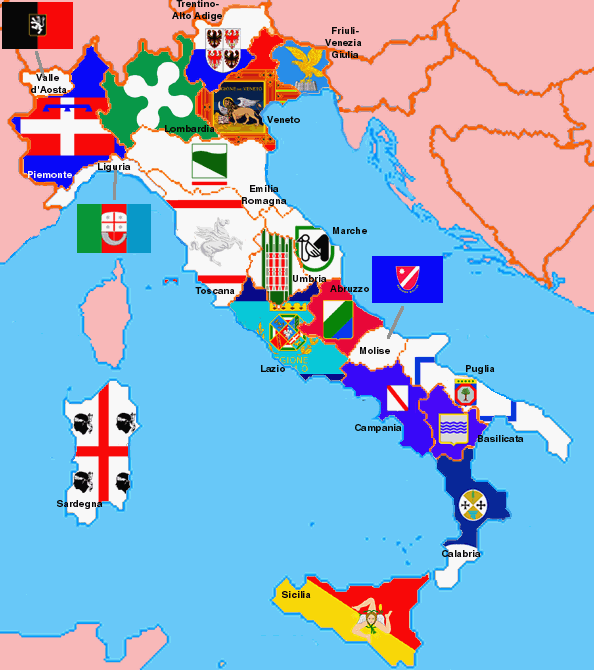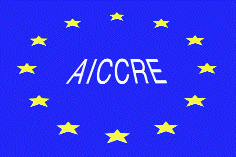
image by Antonio Broto, 10 July 2001

Last modified: 2006-06-17 by dov gutterman
Keywords: italy | aissc | gonfalone |
Links: FOTW homepage |
search |
disclaimer and copyright |
write us |
mirrors

image by Antonio Broto, 10 July 2001
See also:
List of Provinces is taken from <italgen.com/surnames/prov_reg.htm> , located by Jarig Bakker, 23 December 1999
As far as I know, several flags of Italian regions,provinces
and towns are vertically hanged flags. In fact, they are not
flags as we know them, but gonfanons, that is to say that they
are hanged vertically, falling from a metal horizontal bar, and
often being swallow-tailed. Those "flags" have the
proportions 1:2.
pascal vagnat, 7 March 1996
All the Italian towns have one gonfalon, that is
there is one gonfalon which is the official emblem of the town.
Its usage is ruled by law. For instance in the town I live the
town's Statute says the gonfalon can be used only if the Mayor is
present. Usually gonfalons show the coat-of-arms of the town, so
they are not true flags.
giuseppe bottasini, 7 March 1996
I believe all provinces have gonfanon, adopted since the end
of the last century. The legislation authorize the provinces and
communes to have coats of arms and gonfanons. All these emblems
shall be granted by the King (now the president of the Republic).
For the region it is quite the same, though the coats of arms or
logos and the gonfanons are adopted by the regional councils
themselves.Very few provinces have a flag, to my knowledge, but
this is changing
Pascal Vagnat, 28 July 1999
About those provinces, they have only gonfanon with arms in
center and name:
Rimini: White
Crotone: divised V-R
Jaume Olle, 1 August 1999
Despite a great middle age flag tradition, italian towns show a kind of aversion towards flags. Not many of them have a flag adopted by law and usually people don't know about their existence. Many of the flags adopted are simple plain field with the arms in the center (and usually the field is blue), so they all seem the same. Flag exposition is usually limited to municipal building during the reunions of the civic government.
Concerning Italian regional flags, they are known because recently the President Scalfaro asked to all the Regions and autonomous Province to send their flags to be exposed during a conference. Because only about half of the Region had their own flag, the occasion forced many Regions to adopt a flag. Most of them created the flag taking the design from their gonfannon, while Piemonte created a brand new one (but of old and known pattern; while the gonfannon carries the republican colours red-blue-orange, and is little known and even less appreciated). In two cases, Sicily and Puglie, the exposed flags don't correspond to the official ones adopted some years ago: in the first case the shield of the arms have been placed in the middle, substituting the "triquetra"; while in the second the blue and white border has been removed placing two narrow band (green toward the hoist, and red toward the fly) on the white field. Corresponding this to the gonfannon it seems that who sent the flag maybe was unaware that the Region already has adopted one (precisely on 8/9/1988).
If Lega Nord leader Bossi has some merit, one is to have resumed the use of local flags in Italy. I think that without the great efforce toward federalism raised by Lega Nord we will never have regional flags (apart for particular cases as Friuli-Venezia Giulia and Valle d'Aosta).
All the Italian regional and autonomous province flags appear
on Vexilla Italica number 1, volume XXIII (1996);
information on how to get it can be find through CISV.
mario fabretto, 20 September 1996
All Italian regions have an official flag (see Pascal
Vagnat remark below- ed.). These are not gonfalons, are
actual flags. In Piedmont, for example, the law says the regional
flag has to fly together with the national flag and the EU flag
in a number of occasion (e.g. when a town council or the regional
parliament is meeting).
Each region provides its flag to the Quirinale (the official
residency of the Italian President) that displays them in the
"Hall of the Flags of the Regions and the Autonomous
Provinces".
Silvio Sandrone, 20 October 1999
If many regions have a flag, not all have an officially
approved flag. On the other hand, all the regions have a gonfanon
and all, except Molise, have an official one.
The regions with an official flag are: Abruzzo, Basilicata,
friuli-Venezia-Giulia, Liguria, Piemonte, Puglia, Sardegna,
Sicilia, Veneto.
The regions, that have an unofficial flag: Campania, Marche,
Toscana, Valle d'Aosta.
For the other regions, I don't know if they use a flag or not:
Calabria, Lazio, Molise, Trentino-Alto Adige, Umbria.
About the the law of Piedmont about desplaying the flags as
mentioned above, is also true with Liguria and Veneto, which
adopted laws in that sense.
Indeed, Since 1995 each region provides its flag to the Quirinale
Pascal Vagnat , 20 October 1999 and 2 May 2003

imege from <www.agipress.it>
I located the flag of Associazione Italiana per il Consiglio
dei Comuni e delle Regioni d'Europa (Italian Association of the
Councils of Municipalities and of the Region of Europe)
Jarig Bakker, 7 May 1999
I suppose it's rather "Italian Association *for* the
Council of European Communes and *Regions*". Naturally an
exact translation of "Communi" is not possible,
"Comunes" and "Municipalities" would be
equally acceptable -- but I dont know if in Italy there is such
thing as "municipalita'" (as a different administrative
unit than "Communa");
As for the flag itself,It's a "graphical design".This
"prespective" idea however can be given in
"vexillologicaly correct" flags.
Antonio Martins, 7 May 1999